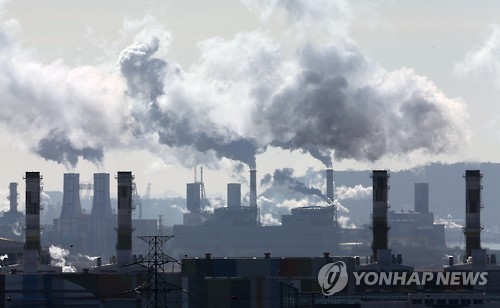South Korea’s energy companies are on alert, as President Moon Jae-in appears determined to carry out his pledge to cut fine dust emissions by 30 percent by reducing the number of coal-fired power plants.
On Monday, Moon ordered the temporary shutdown of outdated coal-fired plants aged 30 years or over. As such, 10 of the nation’s 59 coal-fired plants, located in the Gangwon, South Jeolla, South Chungcheong and South Gyeongsang provinces, will stop operating for a month in June. The government also plans to shut down the 10 plants for four months next year, from March to June.
Moon pledged during the presidential campaign to reassess plans to construct nine new plants, aside from permanently closing old coal-fired plants within his five-year term.
 |
(Yonhap) |
Posco and SK Gas are two of the companies involved in coal-fired power plants.
SK Gas has invested some 300 billion won ($266 million) to date, including money it spent acquiring a 40 percent stake in Dangjin Eco Power in 2014, according to the company. The company also on April 13 signed a memorandum of understanding with state-owned Korea East-West Power to build Dangjin Eco Power. It is now waiting for the Ministry of Trade, Industry and Energy’s construction approval.
As for Posco Energy, in 2014 it invested 431 billion won to wholly acquire Tongyang Power, the company which had held the license to build a thermal power plant in Samcheok, Gangwon Province.
“Not only Posco Energy but other related companies are currently in a wait-and-see mode,” a Posco Energy spokesperson said. “The company will continue the process constructing the unit (in Samcheok), while watching for the government‘s decision on the issue.”
Posco Energy is currently waiting for approval for the Samcheok unit’s environmental impact assessment
Posco, the nation’s No. 1 steelmaker, is also likely to give up on a plan to build a coal power plant in Pohang, as the president is expected to continue strong measures against coal-fired power plants. The company initially started planning on construction to increase its energy self-sufficiency amid increasing costs for electricity, but already faced hurdles in the previous administration for increased calls to cut greenhouse gas emission by 37 percent by 2030.
“Nothing has been decided by the government. For the time being, the industry has to wait and see whether the government will actually reassess plans to construct new coal-fired power plant. It is a little early to discuss follow-up measures at this moment,” an industry insider said.
Korea currently has 59 coal-fired power plants, which account for some 40 percent of the nations’ electricity generation. Nuclear power is the second-biggest source of electricity that produce about 30 percent of the total output. They are also the first and second cheapest sources for generating electricity.
By Shim Woo-hyun (
ws@heraldcorp.com)







![[Today’s K-pop] Blackpink’s Jennie, Lisa invited to Coachella as solo acts](http://res.heraldm.com/phpwas/restmb_idxmake.php?idx=644&simg=/content/image/2024/11/21/20241121050099_0.jpg)
